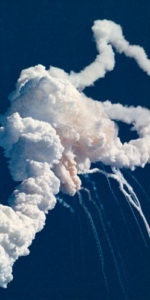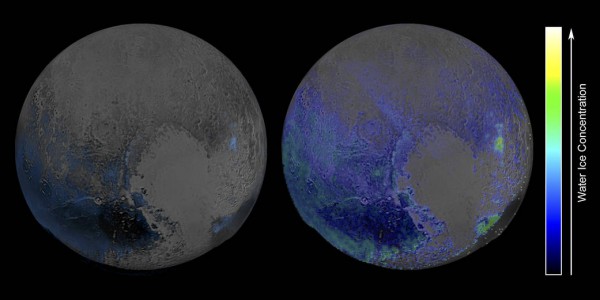
New Horizons has shown Pluto to be a diverse world, more so than many scientists had anticipated, with tall mountain ranges, vast glaciers, a blue-colored layered atmosphere, and possible ice volcanoes. One thing, however, which seemed to be relatively lacking, was exposed water ice. Not much had been seen on the surface, not even in the glacial regions, which are composed of other ices instead. But now, new data indicates there actually is more water ice than had originally been thought.
The results come from the study of infrared light by the Ralph/Linear Etalon Imaging Spectral Array (LEISA) instrument on New Horizons; the data is based on two scans obtained on July 14, 2015, from a range of about 67,000 miles (108,000 kilometers). A false-color image, created from that data, shows the distribution of water ice on Pluto’s surface. The scans were combined to created a multispectral “data cube” which covers the entire hemisphere which was facing Pluto as the spacecraft flew past in July 14, 2015.
Although water ice forms Pluto’s “crustal bedrock,” not much had been seen elsewhere on the surface itself, other than the mountains. In the freezing temperatures of Pluto, far colder than anyplace on Earth, water ice is as hard as rock.
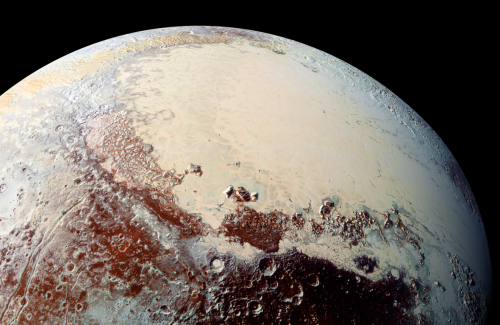
“Large expanses of Pluto don’t show exposed water ice,” said science team member Jason Cook, of SwRI, “because it’s apparently masked by other, more volatile ices across most of the planet. Understanding why water appears exactly where it does, and not in other places, is a challenge that we are digging into.”
Some of the water ice also shows a reddish color, probably from tholins mixed in with the ice.
While water ice is now seen to actually be more widespread, there is little or none in the plains regions such as Sputnik Planum, which forms the left side of the now-famous “heart-shaped” feature, and Lowell Regio. Those plains, and the glaciers feeding them, are composed of ice, but it is methane, nitrogen, and carbon monoxide ice instead of water. Appearance-wise, they resemble glacial deposits on Earth, but their composition is completely different.
One problem is that the spectral signature of water ice can be masked by methane ice, but the new technique can help scientists detect both more easily, as well as the other ices.
The smooth, flat icy plains also show that those regions of Pluto are quite young geologically speaking, probably less than 100 million years, since they are completely crater-free. Pluto also appears to still be geologically active today, an amazing fact given that it is so small and far from the Sun.
“We did not predict that a small planet like Pluto could still be active and would not have completely cooled off,” said Alan Stern, New Horizons Principal Investigator. “The Pluto system surprised us in many ways, most notably teaching us that small planets can remain active billions of years after their formation,” he added. “We were also taught important lessons by the degree of geological complexity that both Pluto and its large moon Charon display.”
From another recently published paper:
“For Pluto, the rugged mountains and undulating terrain in and around TR require geological processes to have deformed and disrupted Pluto’s water ice–rich bedrock. Some of the processes operating on Pluto appear to have operated geologically recently, including those that involve the water ice–rich bedrock as well as the more volatile, and presumably more easily mobilized, ices of SP and elsewhere. This raises questions of how such processes were powered so long after the formation of the Pluto system.”
As also reported recently, the Sputnik Planum basin is thought to have formed from the impact of a huge asteroid or other rocky body, calculated to be about 6.2 miles (10 kilometers) across. The basin later became filled with the nitrogen ice, which has an interesting polygonal, cell-like blocky appearance, with each cell about 10-25 miles wide. The basin is also ringed by tall mountains of rock-hard water ice, creating a “shoreline.” Nitrogen ice flows come down from the mountains and pool in the basin, while large blocks of water ice can be seen “floating” in the nitrogen ice “sea.”
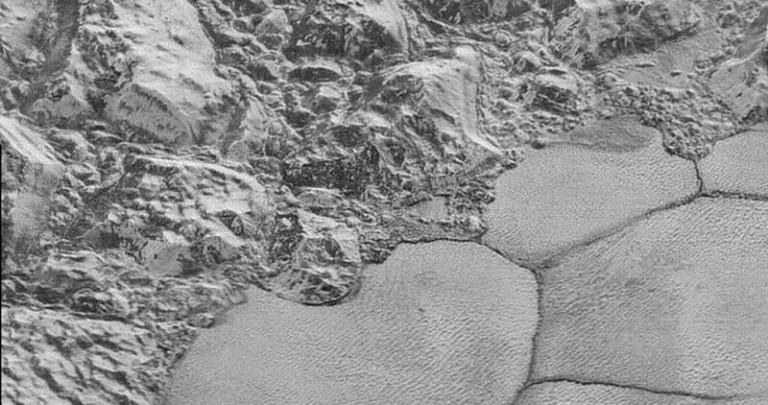
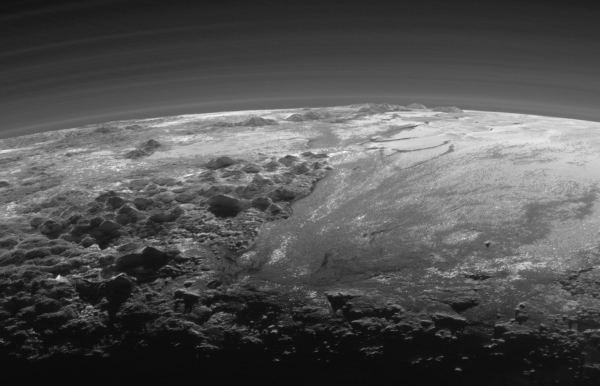
As Stern explained: “Water ice floats in nitrogen ice. These blocks appear to have been removed from a subsurface layer, and they are now ‘floating’ in a large reservoir.”
The surface of this icy plain is covered in many small “pits,” giving it a kind of frothy appearance. These are thought to be evidence of thermal convection, where a reservoir of nitrogen ice below the surface, likely several miles or kilometers deep in some places, is warmed at depth by modest internal heat and then becomes buoyant and rises up in blobs, sort of like a lava lamp. It then cools off and sinks again to renew the cycle. The surface ice is likely being continuously being replenished in this manner.
“This part of Pluto is acting like a lava lamp,” said William McKinnon, deputy lead of the New Horizons Geology, Geophysics and Imaging team, from Washington University in St. Louis, “if you can imagine a lava lamp as wide as, and even deeper than, Hudson Bay.”
While the water ice is as solid as rock, the other ices are more volatile, meaning they can slowly flow, just like glaciers on Earth.
As also reported previously, there may be cryovolcanoes on Pluto, where water ice flows instead of lava. Similar features have been seen elsewhere, such as Neptune’s largest moon, Triton.
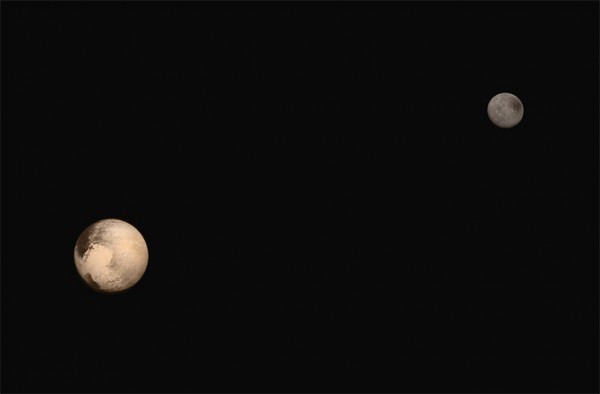
“These are big mountains with a large hole in their summit, and on Earth that generally means one thing – a volcano,” said Oliver White, New Horizons postdoctoral researcher with NASA’s Ames Research Center, Moffett Field, Calif.
Like the glaciers, this is another type of geological activity that resembles some seen on Earth, but with very different materials involved.
The surface of Pluto’s largest moon Charon, however, is dominated by water ice, and also displays clear evidence of geological activity, imcuding mountains, canyons, a reddish northern polar cap, and regions with few craters.
The science data from Pluto will continue to come in for most of this year, and will certainly be studied for many, many more years after that. There is still a lot to learn about Pluto and its moons, as well as other objects in the Kuiper Belt. What else is waiting to be found?
As the paper concluded, “The New Horizons encounter revealed that Pluto displays a surprisingly wide variety of geological landforms, including those resulting from glaciological and surface-atmosphere interactions as well as impact, tectonic, possible cryovolcanic, and mass-wasting processes. This suggests that other small planets of the Kuiper Belt, such as Eris, Makemake, and Haumea, could express similarly complex histories that rival those of terrestrial planets. Pluto’s diverse surface geology and long-term activity also raise fundamental questions about how it has remained active many billions of years after its formation.”
Follow our New Horizons mission page for regular updates.
Be sure to “Like” AmericaSpace on Facebook and follow us on Twitter: @AmericaSpace
Missions » New Horizons »



